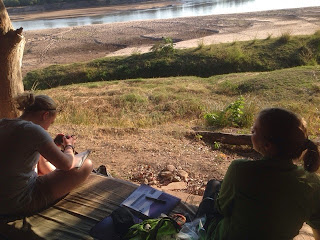The last four days "off the grid" are attributable to our stay with the Banda family in Nyanje village. This was technically "off the clock" as far as biology was concerned, but as most everyone agreed, it was perhaps the most meaningful cultural experience yet in this class. Hopefully these two posts will make clear why.
This year's Nyanje experience started by picking up Alice, second-born of Levenia Banda, from her current residence in Chongwe, just a half-an-hour outside of Lusaka. As Mary (co-leader) observed, "Alice Banda is a force of nature," and a good force, to be sure. Alice rode the next 6 hours on the bus with us, talking about her role as a nurse and as a health care trainer (she trains midwives at over twenty regional health care centers). She also took over my tour guide duties by finding roadside hot springs, by pointing out a major health concerns for rural Zambians, and by demonstrating the subtle differences between bananas purchased in Luangwa compared to those purchased in Nyimba. She knows her stuff.
At the roadside fish market in Luangwa.
After a long drive - with a particularly grueling final half-hour washboard track rivaled only by some of the back roads in the Ottawa National Forest - we finally pulled into Mama (Levenia) Banda's compound in the village, where we were immediately treated to a Welcome Dinner of nshima, greens, beans and and pumpkin. Although many things were absolutely foreign to these Zambassadors (eating with fingers, speaking Nyanja, trying cornmeal paste, etc.) everyone just rolled the experience and had a blast. Here you can see fourth-born Nelia and us as we enjoy our unplanned welcoming dinner.
Some of the gang and Nelia in the sitting room Mama Banda's house.
Here is Mama Banda herself, happily greeting us all and treating all 14 of us to a large, welcome and unexpected meal.
Although we were greeted by many children when we arrived, our immediate whisking away into the sitting room for dinner meant a lot of locals still had yet to shake our hands. And so a stream of Banda relatives and friends began to snake through the tight quarters, shaking everyone's hands and asking, "Bwanji?" To which the Zambassadors replied, "bwino, muli bwanji?"
The stream of greeters continued throughout the next four days. Children were the most curious about us (many had never seen white skin before), but villagers from all walks came to shake our hands and greet us. At almost any moment over those days, someone might appear just to shake our hands and exchange bwanjis. It was gracious, touching and genuine.
Emily (Bertucci) greets a woman who came by during our breakfast of the third day in the village.
After our dinner we made our way back out into the dark night to get our tents set up in the yard of our hostesses, Nelia and Levenia. Children were everywhere, and they were wired with the excitement of our arrival. Within minutes (seconds, really) of having their tent set up, Angela and Emily (Anna) had a welcome-wagonload of at least a dozen children in their tent, and soon Holly, Brian and Andrea (I think - hard to keep track after a while) joined the party tent.
Eventually all but Angela and Emily were shooed out of the tent (it took help from the ever-commanding Alice) and we all got a good night's sleep, readying ourselves for the coming Sunday morning church service.
The next morning before church we had two important visits to take care of - one to the village headman and one to the Chieftaness. Nyanje village is one of the few in Zambia that have a matrilineal chiefdom, which was a slight change from the meeting we had with Chief Chitambo near Kasanka. At any rate, the Headman and the Chieftaness were both quite gracious.
We gave her a T-shirt from NMU, and she honored us by putting it on before heading to church with us. The gentleman in the picture is her husband - the headman had to go back to his house before we got this photo snapped. The chieftaness graciously invited us all into her house, where she showed us pictures from her life as chieftaness. Then she loaded onto our Zambus (temporarily The Royal Zambus) with us and caught a ride to church.
Church (Dutch Reformed Church of Zambia) was a cultural phenomenon unlike anything any of us had experienced. In the two hours of service, we heard probably an hour of singing by five different church choirs. The singing (and dancing) was energetic, to say the least:
We were twice made a part of the service as honored guests. Once as participants in a greeting/snowball dance-song (video above), and once when we were asked to contribute a song of our own before the 300+ person congregation! We tried to beg off the request, stating we were not really a "singing culture," but in the end we pulled off two stanzas of "Amazing Grace." Although I think we were passable (not electric, like their choirs were), we are all thankful to have no video of that to post.
After the service we went back to drop off the chieftaness and have some lunch. We arrived back to our little tent city and found that Nelia made all of us another traditional village meal - nshima, greens, sauce and chicken.
Mary almost brushed this "leaf" off her tent before realizing it was a giant katydid, pictured here with its namesake, Katy!
Later that day, Alice led us on an enlightening tour of the village hospital.
And we capped off the day's activities with a hike up one of the smaller hills that surrounds the village.
The next day's programme was to hike up Nyanje Mountain, help the Bandas around their compound if we could, and hike to the dam. The next post will cover that.



























































